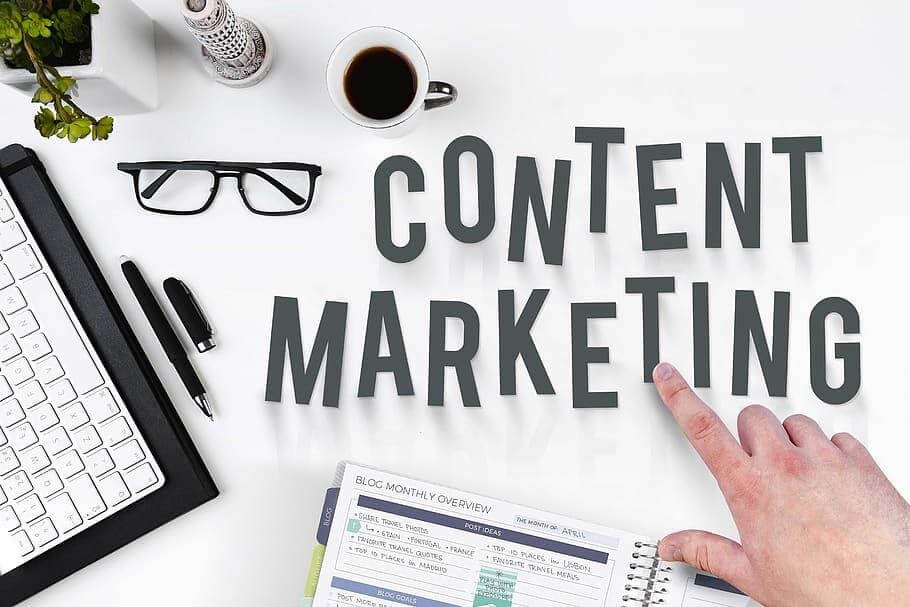
Excellent visual design can drastically boost the efficacy of any content marketing materials and campaigns. Here’s what you should know as a pro designer.
The expression “content is king” has become somewhat overused. But in the online world, content marketing is the key to success. Without a solid content marketing strategy, brands simply won’t be able to effectively engage their audiences. Nor will they retain that engagement long enough to convert them into paying customers.
However, it’s not just good content that engages an audience.
Design plays a major role in the success of any marketing campaign.
It’s up to professional designers to use the right approaches, tools, and industry tricks to create captivating content that helps their clients to meet their customer acquisition objectives.
Here’s how to elevate your content marketing using great design principles and practices.

Image source: https://unsplash.com/photos/CGpifH3FjOA
Create A Cohesive Visual Brand Identity Across All Platforms
Creating a cohesive visual identity across all platforms for a brand is a powerful tool that you should never underestimate. Great brand visuals should communicate a brand’s values, brand personality, and story instantly. These are often the first things target audiences see. Because of this, they may leave a first impression that could make or break conversion rates and the success of a content marketing campaign.
Brand visuals include so much more than just a logo, font, and color scheme.
Formulating a visual identity for a brand takes creative thought, experimentation, and time.
As a designer, it’s important to ask yourself questions like:
What does this brand do?
What makes the brand stand out from its competitors?
What’s the brand’s background and story?
Which values and beliefs underline this brand?
What does the client want target audiences to think about their brand?
The answers to these questions will give you the information you need to develop a suitable visual language for your client’s brand. Use this language to design logos, color schemes, videos, illustrations, layouts, imagery and more that align with the brand’s unique vision and promotes continuity across all platforms.
Use Visual Storytelling To Create A Connection
Visual storytelling is an invaluable way to foster connections between a brand and its audience.
Modern visual storytelling involves the use of images, illustrations, graphics, photographs, and videos to engage with content viewers in a bid to sway their emotions and drive interaction. Marketers have been focusing on these tactics for years. But with the current rise in digital content marketing, they are now looking to savvy designers to bring their brand messages to life.
Your role as a designer is to present messages and data in compelling visual formats.
Visual storytelling is about determining the most effective ways to represent information, such as a brand’s history or values, in a visual way to ensure that it is relevant to the right key audiences. You can use media like video, photojournalism, educational infographics, comics, memes, and GIFs to ensure that your client’s brand messages hit home with their ideal audiences.
You can use media like video, photojournalism, educational infographics, comics, memes, user-generated content and GIFs to ensure that your client’s brand messages hit home with their ideal audiences.
Connor Butterworth, owner of the rug store Southwestern Rugs Depot, found that by adding images of rugs placed in actual rooms to their site, they increased their buyer conversion rate across the board. Customers resonate with realistic images that help them imagine the products in their own homes and lives, instead of generic, stock images with white backgrounds.
Remember, the brain processes visuals 60,000 times faster than it does plain text.
Eye-catching visual content that is authentic, sensory and relevant to the right viewers will amplify a brand’s message. This helps to ensure the success of their content marketing efforts.

Image source: https://www.pxfuel.com/en/free-photo-qllwx
Share Relevant Infographics
Infographics are tools that convey information in a compelling, visual way. These graphic designs work like vehicles that deliver information and clarify concepts, no matter how complex they are. They can deliver information like complex ideas, data and statistics, and repurpose existing content in an exciting new way.
Research has shown that integrating visuals like infographics into content marketing strategies can improve target audiences’ information retention by up to 78%. People that remember a brand’s content are significantly more likely to remember the brand itself and to invest in its products and services when their need arises.
Well-designed infographics can lead to more exposure and sales for a brand. Particularly when people find the content relevant and helpful. The key is to keep these visuals in line with a brand’s identity by adding its logo, sticking to its color schemes, and visually highlighting important information such as your brand’s name using design elements like size and tone.
“In what can be a complex concept to understand, we often use infographics and other imagery to explain our property / building auction service,” comments Ruban Selvanayagam of Property Solvers.
Get Your Image To Text Ratio Right
Image to text ratio is a crucial consideration for every designer.
Choosing the best images for a brand isn’t only about sourcing the ones that look good visually. They need to fit well with your content marketing material designs. plus, you need to consider image size and aspect ratio to ensure that they do.
Furthermore, image to text ratio is still one of the most important deliverability factors in content marketing. When spamming first became commonplace, spam filters were adjusted to scan emails and filter them out based on their text content.
Spammers navigated these changes by converting their content into image-only emails. Unfortunately, if your content marketing mails only contain images and little to no text, they may get flagged as spam. Many email clients will not display images by default unless your mails are added to a recipient’s ‘safe sender’ contact list.
Generally, a 60-40 ratio of text to visuals is favorable. But your content is even more likely to pass spam filters if the ratio is 70-30 or even 80-20. The golden rule is a maximum of 40% image coverage, 60% text coverage, and no more than 3 images on a page.
Provide Value To Create A Lasting Impression
Visual design is important, but it’s also essential to design with functionality in mind.
Offering a teachable or interactive experience rather than just a marketing experience can hold target markets’ attention significantly better. Especially if your content is witty and provides value to customers.
Media like video, GIFs, and chatbots are some of the best vehicles to use to deliver messages that entertain people and inform them at the same time. These media may not sell anything directly. But by providing value, they will encourage viewers to associate a brand with the message on a subconscious level.
Next time they think of your videos, smooth digital experience or visual media, they will automatically think of the brand associated with these factors. They’ll be more likely to explore the brand’s offerings as a result.

Image source: https://www.pxfuel.com/en/free-photo-erixt
Promote Shares And Shareability
Another key tip for content marketing material designers is to create designs, infographics, charts, and videos that drive social media shares. Well designed, visually coherent content encourages people to share it. This grows your client’s brand’s audience organically and exposes them to valuable new pools of potential customers.
Keeping this content in line with a brand’s visual identity will help new audiences to associate value-packed content with the brand you are working with. And to remember them long after exposure.
Conclusion
The internet provides multiple opportunities for online marketing. In this crowded digital space you need to know how to make a brand stand out from the pack. Smart use of design in content marketing can significantly improve the ability to reach, engage, and convert the right target audiences.
Incorporating captivating design elements into a brand’s videos, infographics, and visuals will also encourage viewers to get more actively involved with the brand. They’ll interact with them online and, hopefully, invest in their products and services too.